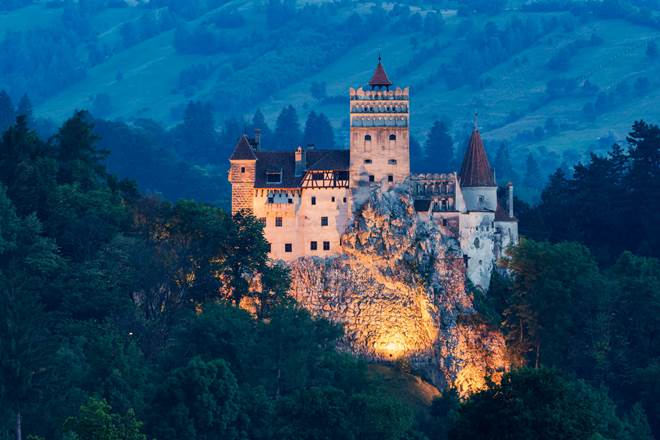“I want you to believe…to believe in things that you cannot.”
Even a century after Bram Stoker’s character spoke them, Van Helsing’s words still challenge readers to believe in the undead. Dracula was published in 1897 and is effectively the source material for all other vampire lore and literature that followed.
If you didn’t skip out on English Literature in high school, you’ll know that the story not only took place in Transylvania, but also throughout the UK. Here’s where you can find what’s believed to be the inspiration behind Dracula’s castle, the real castle that the real Dracula lived in, and the locations that inspired many of Stoker’s scenes.
Aerial view of Bran Castle during the winter in Bran, Transylvania, Romania. Image Credit: Getty Images, warmcolors
Is Dracula's castle still standing in Romania?
Yes, Dracula’s castle is still standing in Romania. Bran Castle, which is often called Dracula’s Castle, is a popular tourist attraction in Bran, Romania, that does not shy away from its literary (or lack thereof) history. If you meant the real Count Dracula — aka Vlad the Impaler who is often cited as an inspiration for Dracula — his Poenari Castle is also still standing (albeit, in ruins) outside of Arefu, Romania. But be aware that the castle is temporarily closed as it is currently undergoing extensive renovations.
Is Dracula's castle in Romania worth visiting?
Dracula’s castle in Romania, Bran Castle, is only worth visiting if you know what to expect. Vlad the Impaler did not live there and it’s not officially confirmed that Bram Stoker based Castle Dracula off of Bran’s facade. However, Bran Castle and most of the city embrace its Dracula associations, which creates a fun, quirky atmosphere for anyone who loves monsters.
How do you get to Dracula's castle in Romania by train?
You can’t get all the way to Dracula’s castle by train, but that’s nothing a simple cab ride can’t fix. If you’re starting in Bucharest, you’ll want to take the train from Bucharest Nord Gara A up to Brasov. This journey takes about 2.5 hours and trains are frequent. From Brasov, take a cab down to Bran Castle.
Related:
Exterior of Snagov Monastery in Romania. Image Credit: Getty Images, vestica
Where is Vlad the Impaler buried?
Rumor has it that Vlad the Impaler was buried at the Snagov Monastery in Romania. Snagov is just north of Bucharest and is open for visitors.
Was Dracula a real person?
Dracula, the famous literary vampire, was just that: a work of fiction. There was a famous Dracula in history, Vlad the Impaler, who was called Vlad Dracula. He was the son of Vlad Dracul. Vlad had a cruel reputation and a penchant for impaling, though much the reports about him may have been exaggerated (for instance, that he used to eat bread dipped in the blood of his victims).
Are there still descendants of Vlad the Impaler?
King Charles III is a descendant of Vlad the Impaler…or so he claims. A genealogy report shows that his great-grandmother was a descendant from Vlad’s sons. Back in 2017, the mayor of Alba, Romania, wanted to grant the then Prince Charles the honorary title of Prince of Transylvania.
Who wrote Dracula and when?
The novel Dracula was written by Bram Stoker in 1897. Its format is an epistolary novel: instead of being told through a first person or third person point of view, the story is told through a collection of written accounts like diary entries, letters, and newspaper articles.
Aerial view of Whitby in Yorkshire, England. Image Credit: Getty Images, Edwin Remsberg
Did Bram Stoker write Dracula in Whitby?
No, Bram Stoker didn’t write the entirety of Dracula in Whitby, but the harbor town was instrumental in the ideation of the story. Of the six years it took Stoker to pen Dracula, he spent a month of it in Whitby. It’s here that he first learned of Vlad the Impaler when visiting the public library and of the shipwrecked Russian vessel called Dmitry. His month in Whitby was so influential that many of the notes, names, and real life details he jotted down made it into the final publication.
Where is Dracula's grave in Whitby?
You’ll hear loads of people — primarily out of towners — claim that Dracula’s grave is in Whitby’s St Mary’s Churchyard. It’s supposedly marked by a headstone featuring a skull and crossbones. If that was true, then it’d be an empty grave because Dracula was a fictional character and Vlad the Impaler is reportedly buried in Romania.
Read also: Visit the famous graves of Morrison and Wilde at Père Lachaise Cemetery
What three cities were circled on Dracula's map?
Harker, a real estate broker with the Hawkins firm, has a conversation with Dracula about purchasing an estate. He notices three cities circled on Dracula’s map: Purfleet, Whitby, and Exeter.
Townscape of Bistrița, Romania. Image Credit: Getty Images, Westend61
Key Dracula locations in Eastern Europe
Eastern Europe should be on your travel to-do list, and if you haven’t mapped out where exactly to explore first, embrace the spooky stories of the region and check out these key Dracula locations.
Bistrița, Romania
Closest station: Bistriţa Nord. | Bistriţa H.
This northern Transylvania city is where readers discover that there’s something a little more sinister to Count Dracula. Peep the stunning views from the tower of Biserica Evanghelică Bistrita.
Galați, Romania
Closest station: Galați
You won’t find St. Peter’s Church in Galați, the spot where Petrof Skinsky was killed. You will find at least a dozen other churches and the Danube River that Dracula sailed through on his escape from Varna.
Read also: Visit these four European cities along the Danube River
Foggy day on the Siret River in Romania. Image Credit: Getty Images, icarmen13
The Sereth River (Siret River), Romania
The Sereth River is the route Mina surmises that Dracula took back to his castle. The real Siret River branches off of the Danube and flows through Romania into Ukraine.
Varna, Bulgaria
Closest station: Varna Central Train Station (Варна)
Varna, a city on the Black Sea, is the place where Dracula boarded the Czarina Catherine as he tries to flee back to his Transylvanian castle.
Hospital of St. Joseph and Ste. Mary, Budapest, Hungary
Closest station: Budapest Keleti station
The Hospital of St. Joseph and Ste. Mary, where Jonathan spent his recovery, isn’t real. But perhaps even cooler is the real life Hospital in the Rock. This museum in Budapest is an underground World War II hospital that was also a Cold War nuclear shelter. It’s available to tour.
199 steps leading to the Whitby Abbey in Whitby, England. Image Credit: Getty Images, BriBar
Key Dracula locations in the UK
Count Dracula’s presence is still (fictionally) felt at these UK locations.
Whitby, England
Closest station: Whitby
Whitby is the harbor town featured in Dracula. You’ll want to visit the clifftop Whitby Abbey which helped inspire the novel. The abbey has 199 steps leading up to it; the same steps the shipwrecked dog ran up in the start of the book. You should also walk by 6 Royal Crescent, where Stoker stayed, and the Dracula Experience for laughs.
Carfax Abbey, Purfleet, England
Closest station: Purfleet
Unfortunately, Dracula’s English estate isn’t real, though the town Purfleet-on-Thames is. The boardwalks of the RSPB Rainham Marshes make for a quiet place to stroll in between chapters.
Dr. Seward’s Asylum, Purfleet, England
Closest station: Purfleet
Since you won’t find Carfax Abbey, you also won’t find Dr. Seward’s Asylum. You aren’t crazy for visiting, though; you can take a guided tour of the Purfleet Heritage & Military Center to learn about Victorian-era Purfleet-on-Thames.
167 Chicksand Street, Mile End, London, England
Closest station: Whitechapel
If you’re looking for where Smollet and Snelling stashed Dracula’s boxes, we’ve got good news and bad news. The bad news is that there is no 197 on Chicksand Street, and Chicksand Street isn’t in Mile End. However, if you go to Chicksand Street in Whitechapel, you’ll be in the former stomping grounds of another legendary monster: Jack the Ripper.
Doolittle’s Wharf, London, England
Closest station: Canary Wharf
Doolittle’s Wharf, where Dracula fled London via the Czarina Catherine, is another work of fiction. Should you need to catch a boat down the Thames, head to Canary Wharf. The London Museum Docklands is a cool place to learn about the city’s trading port history.
Exterior of Exeter Cathedral in England. Image Credit: Getty Images, P A Thompson
Exeter, England
Closest station: Exeter Central
One of the cities circled on Dracula’s map, Exeter is also where Peter Hawkins, Jonathan, and Mina live. The Exeter Cathedral’s medieval Gothic church has rooftop tours that offer a bat’s eye view of the city.
Jamaica Lane, London, England
Closest station: London Bridge
Jamaica Lane, where Smollet and Snelling take Dracula’s boxes, is not a real street. Jamaica Road, however, is; it runs through Southwark where you’ll find The Shard.
Highgate Cemetery, London, England
Closest station: Upper Holloway | Highgate
Highgate Cemetery isn’t just the spot where the vampire Lucy Westernra roamed. Snake through the gravestones and you’ll find famous names like Karl Marx. Dig (figuratively, of course) deeper into the history of Highgate to discover acts of the occult and reports of a vampire in the 1970s.
Hampstead Heath park in London. Image Credit: Getty Images, DILSAD SENOL
Hampstead Heath & Hampstead, London, England
Closest station: Hampstead Heath | Hampstead
The Westminster Gazette in Dracula reports of the Hampstead Horror. Sightings of the Bloofer Lady and reports of missing children make this area extra creepy in the novel. In real life, Hampstead Heath has fewer vampires and safer places for kids to play. Lucy Westenra’s house, Hillingham, is also, fictionally, nearby.
347 Piccadilly & Hyde Park Corner, London, England
Closest station: Hyde Park Corner | Green Park
Jonathan and Mina spot Dracula on Hyde Park Corner along Piccadilly Street, the same street where Dracula lives at number 347.
The Zoological Gardens, London, England
Closest station: Golders Green
Dracula compels a wolf from the Zoological Gardens to break its way into Lucy’s Hillingham house. Golders Hill Park Zoo is closer to Hampstead Heath than the London Zoo, though neither zoo has wolves.
Bela Lugosi as Dracula in Dracula (1931). Image Credit: Universal Pictures
Who was the best Dracula?
Bela Lugosi was the best Dracula. Cinephiles could name Frank Langella or Christopher Lee as the “best”, and for laughs you could say Leslie Nielsen is the GOAT, but there was no one quite like Lugosi. His portrayal as the OG Dracula is still iconic and his role as one of the legendary Hollywood movie monsters still reigns supreme.
Where did they film the Dracula (2020) TV series on Netflix?
Netflix sang their fangs into their own version of the world’s most famous vampire with 2020’s Dracula series. The Castle of Dracula was filmed at Orava Castle in Slovakia. North Yorkshire and Berkshire, England, contributed a number of filming locations, as did some set design in Bray Studios.
Looking for more spooky stories to follow on your journey through Europe? Check out the haunted castles around Frankfurt, including Frankenstein Castle, or explore other remarkable castles throughout Europe.
Plus, these TV shows will get you in the mood. Both Netflix's Wednesday and The Witcher have spooky filming locations in Romania.
Need more travel inspo? Check out these fantasy adventures with filming locations in the UK and Europe:
- The Walking Dead: Daryl Dixon
- Wicked
- Harry Potter
- Game of Thrones
- Shadow and Bone
- The Completely Made-Up Adventures of Dick Turpin
Download the Trainline app and start planning an unforgettable vacation during Halloween in Europe.
Aerial view of Bran Castle in Bran, Transylvania, Romania. Header Image Credit: Getty Images, Jeremy Woodhouse



